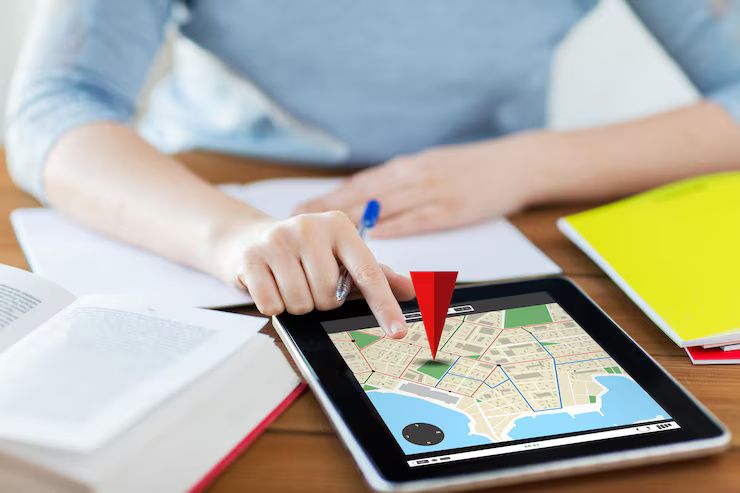Online maps are digital platforms that help users view, plan, and follow routes from one location to another. Tools like Google Maps, Apple Maps, Bing Maps, and Waze offer real-time directions, estimated travel times, traffic data, and nearby services like gas stations, restaurants, and hospitals.
Unlike traditional paper maps, online maps use GPS (Global Positioning System) and internet connectivity to guide you in real-time. You can use them via smartphones, computers, and even car infotainment systems.
Why using online maps matters today
With increasing traffic, larger cities, and more travel needs, online maps are now an essential part of daily life. They are helpful for:
-
Commuters needing real-time traffic updates
-
Travelers and tourists navigating unfamiliar places
-
Delivery drivers and gig workers managing multiple stops
-
Emergency services finding the fastest route
-
Cyclists and walkers looking for safe, efficient paths
These tools help solve common problems like:
-
Getting lost in unfamiliar areas
-
Wasting time in traffic jams
-
Missing exits or turns
-
Not knowing nearby services (fuel, food, hospitals)

Recent updates in online mapping (2024–2025)
Here are some notable developments in the world of online maps over the past year:
| Date | Update/Event | Description |
|---|---|---|
| Feb 2024 | Google Maps launched "Immersive View" | Combines aerial imagery and AI to create 3D street-level previews |
| May 2024 | Apple Maps added offline mode | Users can now download maps and routes for offline navigation |
| Oct 2024 | Waze integrated EV charging station data | Helps electric vehicle drivers plan routes with charging stops |
Regulations, privacy, and user data concerns
Using online maps also brings certain privacy and legal aspects to consider:
-
Location Permissions: Users must grant apps access to their location data. Most platforms allow control over how and when location is shared.
-
GDPR & CCPA: Platforms operating in the EU or California are required to inform users how location data is stored, shared, and used.
-
Usage Limits: Some services may limit use or require a license for commercial or business applications.
Always review the app’s privacy policy and adjust location settings based on your comfort level.
Recommended tools and resources for daily navigation
Here are some of the best online map platforms for everyday use, with key features:
Navigation apps
-
Google Maps
-
Real-time GPS navigation, traffic conditions, and route planning
-
Offers driving, walking, cycling, and transit modes
-
Supports offline maps and indoor maps for malls and airports
-
-
Apple Maps
-
Pre-installed on iPhones and iPads
-
Real-time traffic and lane guidance
-
Offline maps available (as of iOS 17)
-
-
Waze
-
Community-based traffic and hazard reports
-
Great for drivers avoiding congestion
-
Voice directions and speed alerts
-
-
HERE WeGo
-
Offers free downloadable maps for offline use
-
Public transportation info in over 1,300 cities
-
Clear route options for different travel modes
-
Specialized tools
-
Komoot – Best for outdoor hiking and cycling routes
-
Maps.me – Lightweight offline map app, good for travelers
-
Citymapper – Excellent for public transit in large cities
Additional helpful features
-
Street View: Visual preview of places (Google Maps)
-
Live Traffic: Real-time congestion and accidents (Waze, Google)
-
Estimated Arrival Times: Updates based on traffic conditions
-
Saved Places: Favorite locations stored for quick access
Example: Comparing features of top navigation apps
| Feature | Google Maps | Apple Maps | Waze | HERE WeGo |
|---|---|---|---|---|
| Offline maps | ✅ Yes | ✅ Yes (2024) | ❌ No | ✅ Yes |
| Traffic updates | ✅ Live | ✅ Live | ✅ Community | ✅ Live |
| Transit directions | ✅ Yes | ✅ Yes | ❌ No | ✅ Yes |
| EV charging info | ✅ Yes | ❌ No | ✅ Yes | ✅ Yes |
| Walking/Cycling support | ✅ Full | ✅ Limited | ✅ Limited | ✅ Full |
Frequently asked questions about using online maps
1. Can I use online maps without an internet connection?
Yes. Apps like Google Maps, HERE WeGo, and Apple Maps allow you to download offline maps. Make sure to download them before you lose your internet signal.
2. Are navigation apps free to use?
Most navigation apps are free for personal use. Premium features may exist in some apps, like Komoot, for advanced routing.
3. How accurate are real-time traffic updates?
Traffic data is usually accurate as it’s sourced from GPS signals of mobile devices. However, sudden accidents or construction may not always be reflected immediately.
4. Are online maps safe to use while driving?
Yes, but it's important to use them hands-free or with voice navigation. Many apps also integrate with vehicle infotainment systems (Android Auto, Apple CarPlay).
5. How do I report incorrect information on a map?
Most apps allow users to suggest edits. In Google Maps, for instance, you can "Report a problem" on locations, directions, or routes.
Final thoughts
Online maps are more than just digital versions of paper maps. They are intelligent navigation systems that help us commute, travel, and explore safely and efficiently. With features like real-time updates, offline access, and multi-mode support, these tools are becoming daily essentials.
